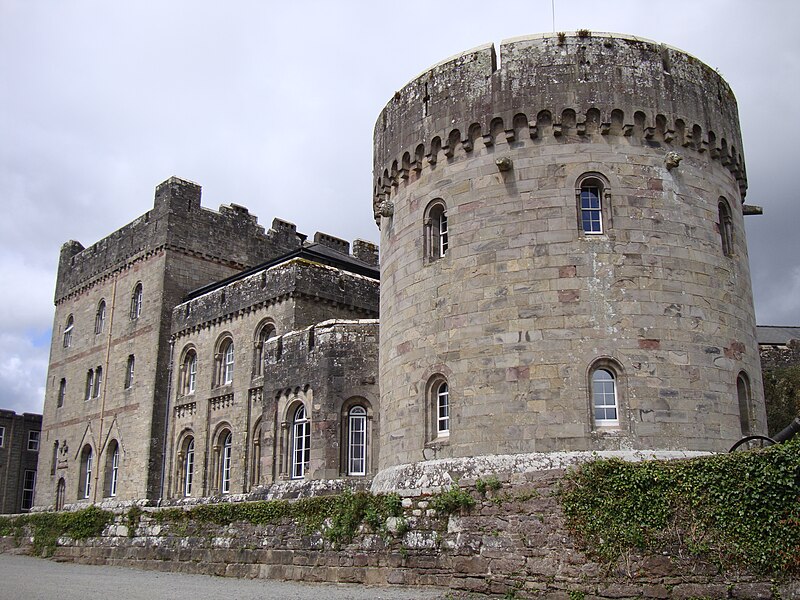THE EARLS OF CARRICK OWNED 1,368 ACRES OF LAND IN COUNTY KILKENNY
This family claims a common ancestor with the noble house of Ormond, namely,
THEOBALD WALTER, who accompanied
HENRY II into Ireland, and settled there, having acquired large possessions, and being appointed, in 1177, Chief Butler of Ireland, the duty of which office consisted in the butler for the time being attending the Kings of England at their coronation, and presenting them with the first cup of wine, for which services he was to receive certain pieces of the King's plate.
From this Theobald descended lineally,
EDMUND BUTLER (1268-1321), who sat in parliament, 1302, as a baron, by the name of Edmund Le Boteler, and was created, by
EDWARD II, for his services against the Scots, 1315, EARL OF CARRICK, County Tipperary.
This nobleman wedded, in 1302, Joan, daughter of John, 1st Earl of Kildare, and had issue,
James, cr EARL OF ORMOND;
JOHN, of whom we treat;
Lawrence;
William;
Joan; Margaret; Alice.
From the second son of this nobleman,
JOHN BUTLER (1305-30), of Clonamicklon, County Tipperary, lineally descended
SIR PIERCE BUTLER, Knight, of Lismalin, a lieutenant-general serving under Lord Mountgarret, who was elevated to the peerage, in 1629, as
Viscount Ikerrin.
His lordship married Ellen, second daughter of Walter, 11th Earl of Ormond, and was succeeded by (the son of his deceased eldest son, James, and his wife, Ellen, eldest daughter of Edmund, Lord Dunboyne) his grandson,
PIERCE, 2nd Viscount (1637-
c1680), who conformed to the established church.
He wedded Ellenor, daughter of John Bryan, of Bawnmore, County Kilkenny, and was succeeded by his son,
JAMES, 3rd Viscount, who held the commission of Captain of Grenadiers in
JAMES II's army.
He espoused Eleanor, eldest daughter and co-heir of Colonel Daniel Redman, of Ballylinch, and dying in 1688, was succeeded by his eldest son,
PIERCE, 4th Viscount (1679-
c1710), who married firstly, Alicia, eldest daughter of Murrough, 1st Viscount Blesington, by whom he had a son,
JAMES, his successor; and secondly, in 1703, Olivia, only daughter of Sir Oliver St George Bt, and widow of Sir Robert Colvil, Knight, but had no other issue.
His lordship was outlawed in 1690 for his adherence to the banner of
JAMES II; his titles and lands were restored, however, in 1698.
He was succeeded by his only son,
JAMES, 5th Viscount (1698-1712); at whose decease, in minority and
unmarried, the title reverted to his uncle,
THOMAS, 6th Viscount (1683-1719); in holy orders and chaplain-general to the army in Flanders under the command of James, Duke of Ormonde.
His lordship espoused Margaret, daughter and co-heir of James Hamilton, of Bangor, County Down, and was succeeded by his eldest son,
JAMES, 7th Viscount (1714-21); at whose decease, in his eighth year, the title devolved upon his brother,
SOMERSET HAMILTON, 8th Viscount (1719-74), who espoused, in 1745, Juliana, eldest daughter of Henry Boyle, of Castle Martyr, afterwards created Earl of Shannon, and had issue,
HENRY THOMAS, his successor;
James;
Pierce
Margaret, m 1st Earl of Belmore;
Henrietta, m 11th Viscount Mountgarret.
His lordship was sworn of the Privy Council, 1746, and advanced to the dignity of an earldom, in 1748, as EARL OF CARRICK (second creation).
He was succeeded by his elder son,
HENRY THOMAS, 2nd Earl (1746-1813), who wedded, in 1774, Sarah, second daughter and co-heir of Edward Taylor, of Askeaton, County Limerick, and had issue,
SOMERSET RICHARD, his successor;
HENRY EDWARD, father of HENRY THOMAS BOYLE;
Pierce;
James;
Anne; Juliana; Harriet; Sarah.
His lordship was succeeded by his eldest son,
SOMERSET RICHARD, 3rd Earl (1779-1838), who espoused firstly, in 1811, Anne, eldest daughter of Owen Wynne, of Hazelwood, County Sligo, and had two daughters, viz.
Sarah Juliana;
Anne Margaret.
He married secondly, in 1833, Lucy, third daughter of Arthur French, of French Park, and had two sons and a daughter, of whom the elder,
HENRY THOMAS, 4th Earl (1834-46), died a minor and was succeeded by his brother,
SOMERSET ARTHUR, 5th Earl,
- Charles Henry Somerset Butler, 6th Earl (1851–1909);
- Brian Stuart Theobald Somerset Caher Butler, 9th Earl (1931–92);
- David James Theobald Somerset Butler, 10th Earl (1953–2008);
- (Arion) Thomas Piers Hamilton Butler, 11th Earl (b 1975).
MOUNT JULIET,
Thomastown, County Kilkenny, is an 18th century house of 1760-65, built for the 1st Earl of Carrick.
The mansion stands on the right bank of the River Nore, where the original family seat, Ballylinch Castle, stood.
It crowns a venerably wooded rising ground.
Mount Juliet comprises three storeys over a basement.
It has seven bays between two curved bows.
Its roof is notably high-pitched, with particulary large chimney-stacks.
Mount Juliet was opulently decorated by the 2nd Earl in the 1780s with plasterwork in the manner of Michael Stapleton.
The 6th Earl sold the estate in 1914 to the McCalmonts, who had leased the house for a number of years.
Major Dermot McCalmont created a new entrance from what had formerly been the rear of the house.
The demesne, extensive and magnificent, is said to be one of the finest in Ireland.
Mount Juliet has been famous for its stud, established by Major McCalmont in 1915, with
The Tetrarch as first sire.
The estate was purchased in 1987 by the Killeen Group and transformed into a luxury hotel and leisure complex.
First published in September, 2015. Carrick Arms courtesy of European Heraldry.


















